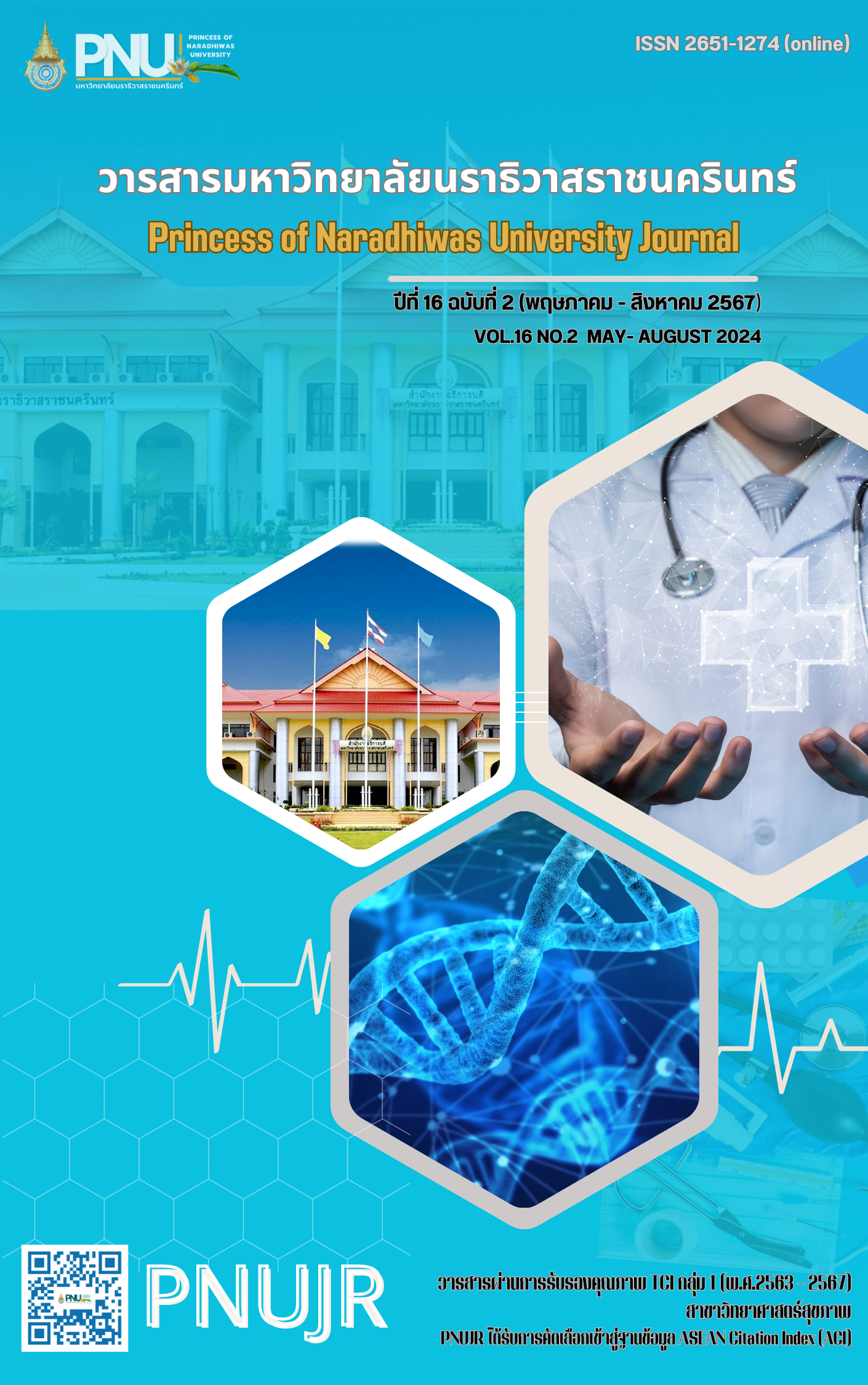ความชุกและปัจจัยที่มีความสัมพันธ์ต่อการตกเลือดในผู้ป่วยที่ได้รับการผ่าตัดคลอดทาง หน้าท้อง โรงพยาบาลทุ่งสง จังหวัดนครศรีธรรมราช
เบญจวรรณ ละหุการ
คำสำคัญ:
การผ่าตัดคลอดทางหน้าท้อง, , ภาวะตกเลือดภายใน 24 ชั่วโมงแรกหลังคลอด, ปัจจัยเสี่ยงบทคัดย่อ
การวิจัยครั้งนี้ เป็นการศึกษาย้อนหลังเชิงพรรณนา มีวัตถุประสงค์เพื่อศึกษาความชุกของสถานการณ์ภาวะตกเลือดภายใน 24 ชั่วโมงแรกหลังคลอด และหาความสัมพันธ์ระหว่างปัจจัยด้านประชากรและด้านปัจจัยทางการแพทย์กับภาวะตกเลือดภายใน 24 ชั่วโมงแรกหลังคลอด ในมารดาที่ได้รับการผ่าตัดคลอดทางหน้าท้อง โรงพยาบาลทุ่งสง นครศรีธรรมราช กลุ่มตัวอย่าง คือมารดาที่ได้รับการผ่าตัดคลอดทางหน้าท้องตั้งแต่อายุครรภ์ 28 สัปดาห์เป็นต้นไป จำนวน 397 คน เครื่องมือวิจัย ประกอบด้วย 3 ส่วน คือ ส่วนที่ 1 ข้อมูลส่วนบุคคล ส่วนที่ 2 คือ ปัจจัยทางการแพทย์ พัฒนาขึ้นจากการทบทวนวรรณกรรมที่เกี่ยวข้อง และส่วนที่ 3 คือภาวะตกเลือดหลังคลอดในผู้ป่วยผ่าตัดคลอดทางหน้าท้อง ค่าดัชนีความตรงตามเนื้อหา (Index of Item Objective Congruence: IOC) ได้ค่าดัชนีความสอดคล้องของวัตถุประสงค์การวิจัยรายข้อที่ 1.00 โดยเก็บข้อมูลจากเวชระเบียนหญิงตั้งครรภ์ที่ได้รับการผ่าตัดคลอดทางหน้าท้อง โรงพยาบาลทุ่งสง จังหวัดนครศรีธรรมราช ระหว่างวันที่ 1 มกราคม 2564 – 31 ธันวาคม 2566 วิเคราะห์ข้อมูลทั่วไปโดยใช้สถิติพรรณนา ความถี่ ร้อยละ ส่วนเบี่ยงเบนมาตรฐาน และการวิเคราะห์ถดถอยโลจีสติก ผลการวิจัย พบว่า
- ความชุกของสถานการณ์ภาวะตกเลือดภายใน 24 ชั่วโมงแรกหลังคลอด ในมารดาที่ได้รับการผ่าตัดคลอดทางหน้าท้อง มีความชุก ร้อยละ 97
- ปัจจัยที่มีความสัมพันธ์ต่อการเกิดภาวะตกเลือดภายใน 24 ชั่วโมงแรกหลังคลอด อย่างมีนัยสำคัญทางสถิติ ประกอบด้วย ปัจจัยด้านประชากร คือ อายุครรภ์มากกว่า 40 สัปดาห์ (OR =888, 95 % CI = 1.037-3.438; p = 0.038) และ ปัจจัยทางการแพทย์ คือ ปริมาณการสูญเสียเลือดมากกว่าหรือเท่ากับ 1,000 มิลลิลิตร (OR = 218.52, 95 % CI = 92.978-513.587; p = 0.000)
ผลการศึกษาครั้งนี้ ทีมสหวิชาชีพสามารถนำไปวางแผนการดูแลและป้องกัน เพิ่มประสิทธิภาพในการควบคุมภาวะตกเลือดภายใน 24 ชั่วโมงแรกหลังคลอด ในมารดาที่ได้รับการผ่าตัดคลอดทางหน้าท้องได้
เอกสารอ้างอิง
Aiamcharoen, T. (2017). Postpartum Hemorrhage: Significance of Nurse’s Roles in Prevention. Association of Private Higher Education Institutions of Thailand Journal, 6(2), 146 - 157. https://apheit.bu.ac.th/jounal/science-july-2560/15_17_94_proof1_formatted.pdf
Ameh, C., & Althabe, F. (2022). Improving postpartum hemorrhage care: policy, practice, and research. International Journal of Gynecology & Obstetrics, 158(s1), 4 - 5. https://doi.org/ 10.1002/ijgo.14271
Anusornteerakul, S. (2014). First Two Hours Postpartum Hemorrhage Prevention:Midwives’ Role. Journal of Nursing science and Health, 37(2), 155 - 162. https://he01.tci-thaijo.org/index.php /nah/article/view/22267
Aunnet, C. (2023). Nursing care for Mothers after caesarean section with early postpartum hemorrhage with severe hypovolemic shock: 2 case study. Mahasarakham Hospital Journal, 20(3), 236 - 250. https://he02.tci-thaijo.org/index.php/MKHJ/article/view/265662
Briley, A., Seed, P.T., Tydeman, G., Ballard, H., Waterstone, M., Sandall, J., Poston, L., Tribe, R.M., & Bewley, S. (2014). Reporting errors, incidence and risk factors for postpartum haemorrhage and progression to severe PPH: a prospective observational study. BJOG: An International Journal of Obstetrics & Gynaecology, 121(7), 876 - 888. http://doi.org/10.1111/ 1471-0528.12588.
Carroll, M., Daly, D., & Begley, C.M. (2016). The Prevalence of women’s emotional and physical health problems following a postpartum hemorrhage: a systematic review. BMC Pregnancy and Childbirth, 16(1), 261 - 275. https://doi.org/10.1186/s12884-016-1054-1
Churos, S. (2019). Prevention of Postpartum Hemorrhage: Nurse’s Role. Journal of Medical Sciences, Region 11, 33(1), 30 - 45.
https://he02.tci-thaijo.org/index.php/Reg11MedJ/article/view/191729
Cunningham, F.G., Leveno, K. J., Bloom, S. L., Hauth, J. C., Rouse, D. J., & Spong, C.Y. (2022). William’s obstetrics. (26st ed.). McGraw-Hill. https://accessmedicine.mhmedical.com/book. aspx?bookID=2977
Department of Health. (2023, January 1). Analysis of maternal mortality situation fiscal year 2023. http://hp.anamai.moph.go.th/th/maternatnomaliry-ration/download?id=1063102mid=30954 & mkeyom_document&lang=th&did =30671
Eran, A., Riki, B.B, Amir, A., Eran, H., Yariv, Y., & Liran, H. (2021). Risk factors for postpartum hemorrhage following cesarean delivery. The Journal of Maternal-Fetal & Neonatal Medicine, 35(18), 3626 - 3630. https://doi.org/10.1080/14767058.2020.1834533
Francoise, V., Chloe, B., Bruno, P., & Didier, L. (2016). Incidence of immediate Postpartum Hemorrhage in French maternity units: A Prospective Observational Study. (HERA study). BMC Pregnancy and Childbirth, 16, 242 -250. https://doi.org/10.1186/s12884-016-1008-7
Jongsomchai, C. (2017). Postpartum Hemorrhage. Srinagarind Medical Journal, 32(4), 6 - 18. https://li01.tci-thaijo.org/index.php/SRIMEDJ/article/view/94286
Kyriaki, M., Ioannia, T., Themistoklis, D., Riola, G., Apostolos, M., Apostolos, A., & Ioannis, K. (2023). Incidence and Risk Factors for Postpartum Hemorrhage: A Case-Control Study in Tertiary Hospital in Greece. Medicine, 59(6), 1151. https://doi.org/10.3390/medicina59061151
Michelet, D., Ricbourg, A., Rossignol, M., Schurando, P., & Barranger, E. (2015). Emergency Hysterectomy for Life-threatening postpartum hemorrhage: Risk Factors and Psychological Impact. Gynecologic Obstetric and Fertilities, 43(12), 773 - 779. https://doi.org/10.1016/ j.gyobfe.2015.10.010.
Pillitteri, A. (2014). Maternal and Child health Nursing: Care of the childbearing and childrearing Family (7th ed.). Lippincott. https://www.sciepub.com/reference/186992
Ria, G., & Farida, K. (2023). Factors Affecting Postpartum Hemorrhage on Postpartum Mother. Placentum Jurnal Ilmiah Kesehatan dan Aplikasinya, 11(1), 13 - 22. https://jurnal.uns.ac.id/ placentum/article/view/55528
Sasunee, T. (2022). Risk Factors for Postpartum Hemorrhage in Photharam Hospital, Ratchaburi Province. Journal of Health and Environmental Education, 7(2), 45 - 56. http://s006.tci-thaijo.orf/index/php/hej/article/view/258236
Sijjan, L., Jinsong, G., Juntao, L., Jing, H., Xiaoxu, C., Jing, H., Yabing, T., Xinghui, L., Yinli, C., Xiaowei, L., & Xietong, W. (2021). Incidence and Risk factors of Postpartum Hemorrhage in China: A Multicenter Retrospective Study. Frontiers in Medicine, 8, 673500. https://doi.org/10.3389/fmed.2021.673500
Sinsooksai, N. (2017). Postpartum hemorrhage: Nursing role. In Sumeksi, S., Wongphaitoon, N., Podungkietwitthana, P., & Srisantirorote, N. (Eds.), Advancing together for perinatal care 4.0 (p. 91-96). Union printing.
Solwayo, N. (2016). Postpartum Hemorrhage: Incidence, Risk factors, and Outcomes in a low-resource setting. International Journal of Women’s Health, 8, 647 - 657. https://doi.org/10. 2147/IJWH.S119232
Stevens, J. (1996). Applied Multivariate Statistics for the Social Sciences. Mahwah, N.J.: Lawrence https://www.sciepub.com/reference/52
Suyawej, R., Keesakul, C., Ittichaikulthol, W., & Sonkhammee, P. (2015). Factors affecting postpartum hemorrhage during caesarean section. Thai Journal of Anesthesiology, 41(2), 53 -63. https://he02.tci-thaijo.org/index.php/anesthai/article/view/58704
Thaiyanan, J. (2023). Prevalence and Risk Factor Affecting Early Postpartum Hemorrhage Among Vaginal Delivery at Burapa University Hospital. Burapa Journal Medicine, 10(1), 1 - 17. https://he01.tci-thaijo.org/index.php/BJmed/article/view/257684
Thung Song Hospital Nakhon Si Thammarat. (2023). Report Maternal and Child Health 2020-2022. (Research Report). Thung Song Hospital Nakhon Si Thammarat. https://www.reportlinker. com/market-report/Healthcare/520050/Maternal-Health
Tort, J., Rozenberg, P., Traore, M., Fournier, P., & Dumont, A. (2015). Factors associated with postpartum hemorrhage maternal death in referral hospitals in Senegal and Mali: a cross-sectional epidemiological survey. BMC Pregnancy and Childbirth, 15, 235. https://bmcpregnancychildbirth.biomedcentral.com/articles/10.1186/s12884-015-0669-y
Wilert, S., Iamchareon T., & Yodrak, D. (2019). Situation and Factors Associated with Maternal Postpartum Hemorrhage with Vaginal Delivery in the Obstetric Ward, Noparatrajathanee Hospital. Journal of the Nurses Association of Thailand, 9(2), 173 - 190. https://www.researchgate.net
/publication/342946234_Situation_and_Factors_Associated_with_Maternal_Postpartum_Hemorrhage_with_Vaginal_Delivery_in_the_Obstetric_Ward_Nopparatrajathanee_Hospital
Wongwiriyawech, B., Jansanorot, N., & Thianchaitatsak, C. (2018). Factors Affecting Warly Postpartum Hemorrhage at Prachomklao Hospital, Phetchaburi Province. Journal of Prachomklao College of Nursing, Phetchaburi Province, 1(1), 39 – 47. https://he01.tci-thaijo.org/index.php/pck/article/view/169857
World Health Organization. (2023, January 1). Trends in Maternal Mortality: 2019 – 2023. http//data.unicef.org/topic/maternal-health/maternal-mortality/
ดาวน์โหลด
เผยแพร่แล้ว
รูปแบบการอ้างอิง
ฉบับ
ประเภทบทความ
สัญญาอนุญาต
ลิขสิทธิ์ (c) 2024 วารสารมหาวิทยาลัยนราธิวาสราชนครินทร์

อนุญาตภายใต้เงื่อนไข Creative Commons Attribution-NonCommercial-NoDerivatives 4.0 International License.




